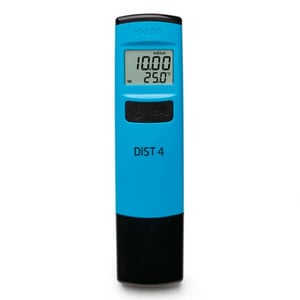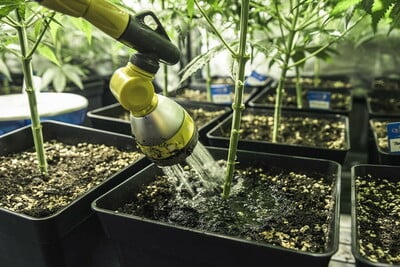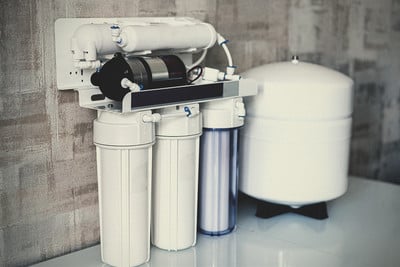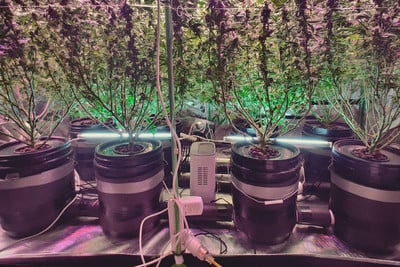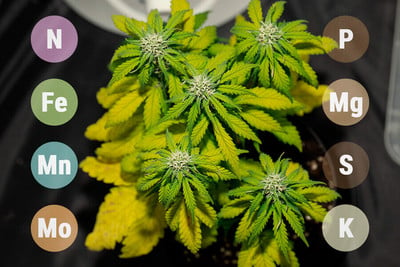 Weed Grow Guide by Royal Queen Seeds
Weed Grow Guide by Royal Queen Seeds
- Growing weed step by step
- Cannabis growing basics
- Choosing your seeds
- How to germinate seeds
- The cannabis vegetative stage
- The cannabis flowering stage
- Harvesting cannabis
- Trimming, drying, and curing
- Choosing pots and soil
-
Growing indoors
- A Complete Overview Of Growing Cannabis Indoors
- Cannabis Cultivation Tips: How To Set Up Indoor Grow Lights
- How Many Cannabis Plants Can You Grow Per Square Metre?
- Indoor Cannabis Growing: Relative Humidity and Temperatures
- Hydroponics Cannabis Growing Guide (with diagrams)
- Cannabis Micro Growing: Growing Great Weed in Tiny Spaces
- Growing outdoors
- How to grow autoflowering cannabis
- Cannabis nutrients and pH
- Cannabis troubleshooting: Nutrients
-
Cannabis troubleshooting: Growing
- Cannabis Seed Germination — Troubleshooting Guide
- How to Deal With Pythium (Root Rot) in Cannabis Plants
- Slow Cannabis Plant Growth And What You Can Do About It
- How to Prevent and Fix Stretching in Cannabis Seedlings
- Watering Your Cannabis: How to Fix Overwatering and Underwatering
- Understanding Male, Female, And Hermaphrodite Cannabis
- Identifying and Treating Common Cannabis Ailments
- How To Revive a Sick Cannabis Plant
- How to Avoid Mouldy Weed During Drying and Curing
- How to Prevent and Treat Dry and Crispy Cannabis Leaves
- What Cannabis Leaves Can Tell You
- Causes and Solutions for Yellow Cannabis Leaves
-
Cannabis Strains Grow Report
- HulkBerry Automatic Grow Report
- Blue Cheese Auto Grow Report
- Purple Punch Automatic Grow Report
- Triple G Automatic Grow Report
- Do-Si-Dos Automatic Grow Report
- Green Gelato Automatic Grow Report
- Haze Berry Automatic Grow Report
- Purple Queen Automatic Grow Report
- Cookies Gelato Automatic Grow Report
- Sherbet Queen Automatic Grow Report
- Sweet Skunk Automatic Grow Report
- Medusa F1 Grow Report
- Cannabis plant training
-
Weed growing tips
- The Cannabis Plant Anatomy
- How to preserve seeds
- How Much Sunlight Do Outdoor Cannabis Plants Need To Grow?
- How to Control and Prevent Stretching in Cannabis Plants
- My Cannabis Plants Are Growing Too Tall: What Should I Do?
- Should You Worry About Purple Or Red Cannabis Stems?
- What To Do When Your Indoor Cannabis Won’t Flower
- How To Protect Your Cannabis Plants From Heat Stress
- How To Tell If Your Female Cannabis Plant Has Been Pollinated
- Growing Medical Marijuana
- Bud Washing: How to Clean Your Weed
- Understanding Cannabis Yield per Plant

Cannabis & Water Quality Part 2: PPM & EC
Contents:
Water is a foundation of life. This is no less true for cannabis, which relies on water for a whole array of functions. In our previous blog on water quality, we assessed why water is important, and how pH can affect many aspects of your grow. Today we are going into a bit more detail with ppm and EC. Both are more advanced aspects of cannabis growing that need to be taken into account, and getting your head around it will help push your skills to the max. For the novice, while important, this information is not essential to grow. It is still possible to get great results without it, but it will certainly help!
How To Measure Nutrient Concentration
To understand the nutrient concentration of your soil, you’ll want to test both the pH and PPM or EC of your runoff.
PPM: Add The Right Amount Of Nutrients Every Time
PPM is a measurement that gives you an indication of the amount of nutrients present in your growing medium. This is super important as it guides your next feed and allows you to avoid over- or underfeeding your plants. Measuring PPM is simple and can be done using most TDS meters.
How To Manage Runoff EC
EC, or electrical conductivity, is another measurement that helps us determine the amount of nutrients present in the growing medium. The more nutrients in the medium, the higher the EC reading of your runoff. Measuring EC is simple with our DiST 4 Pocket Conductivity Tester by Hanna Instruments. Remember to measure your runoff regularly to know when to feed your plants, and how much to feed them.
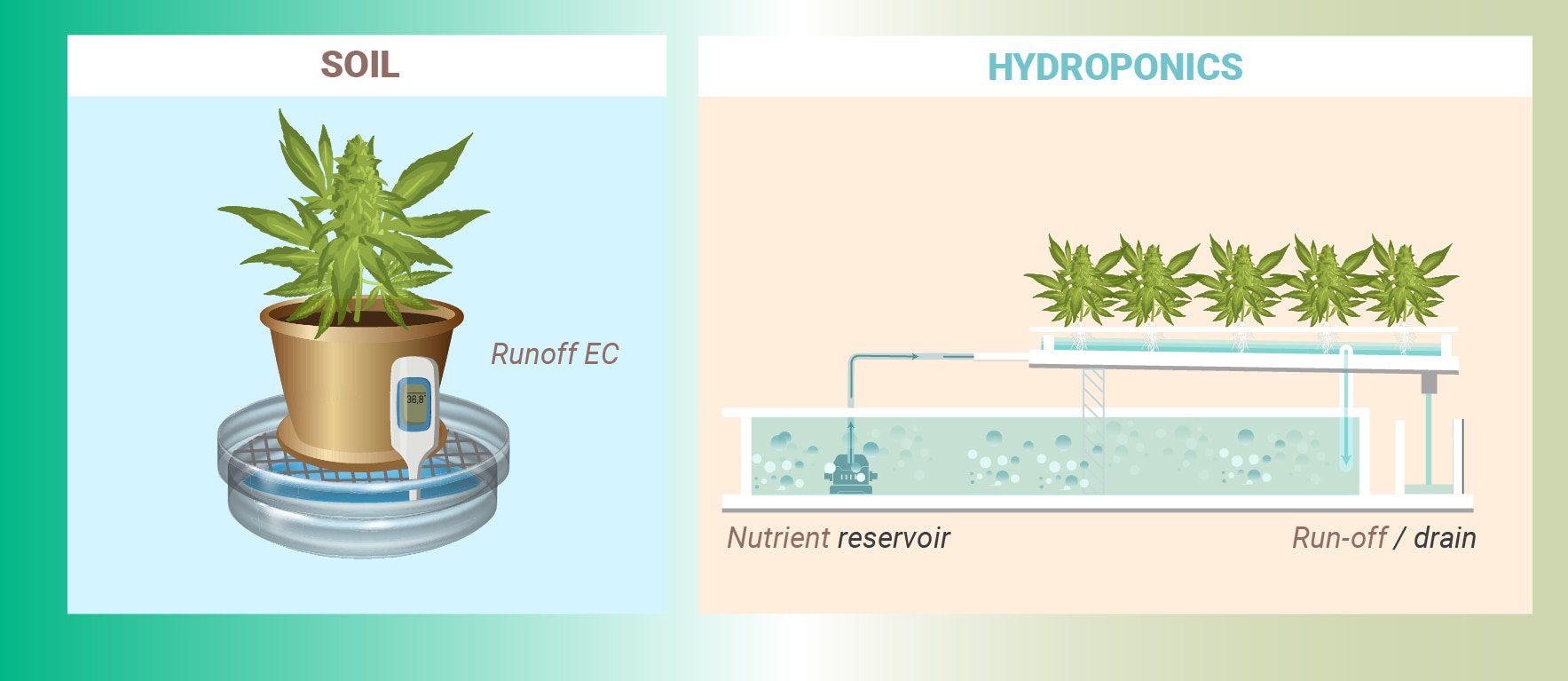
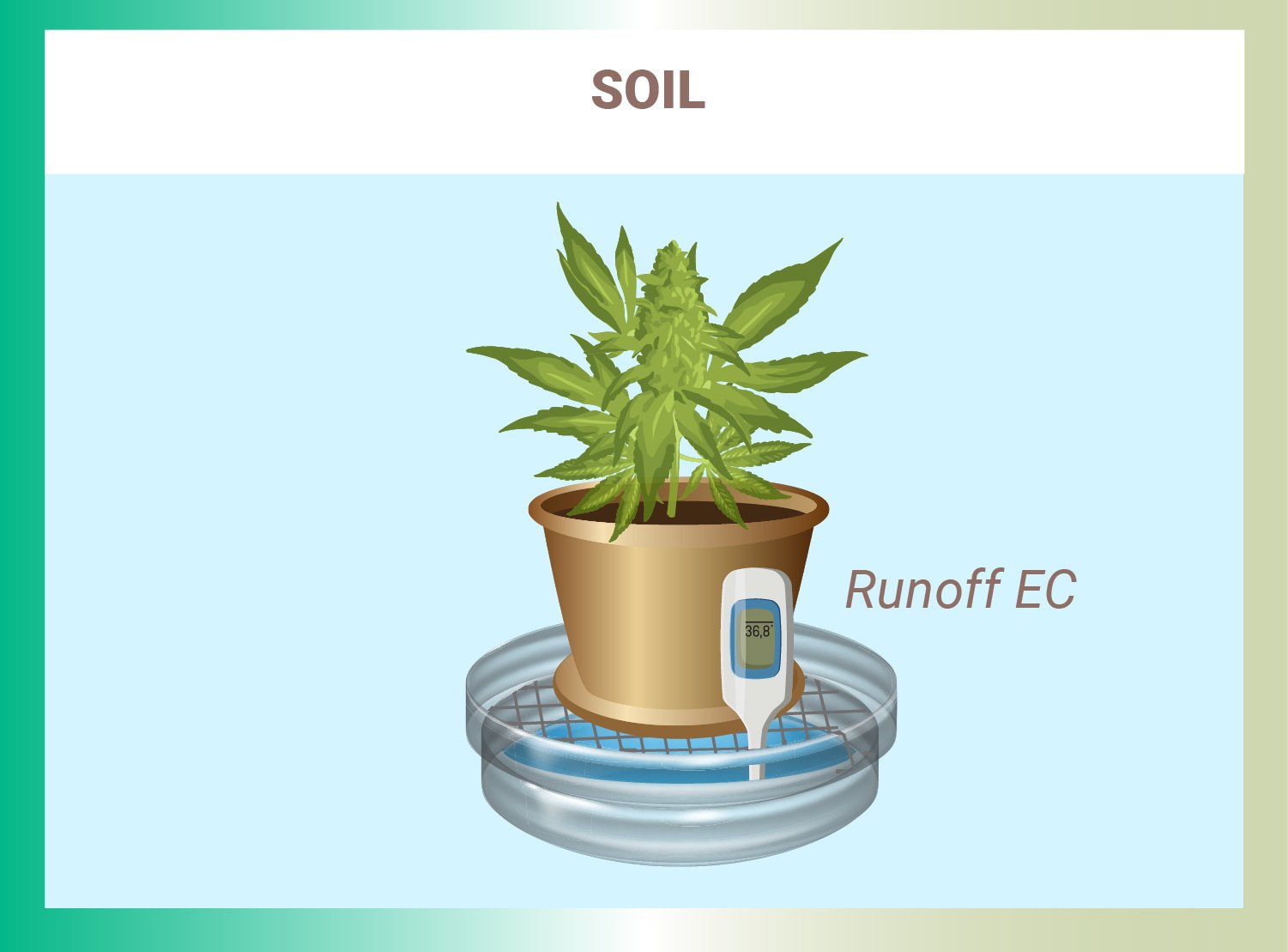
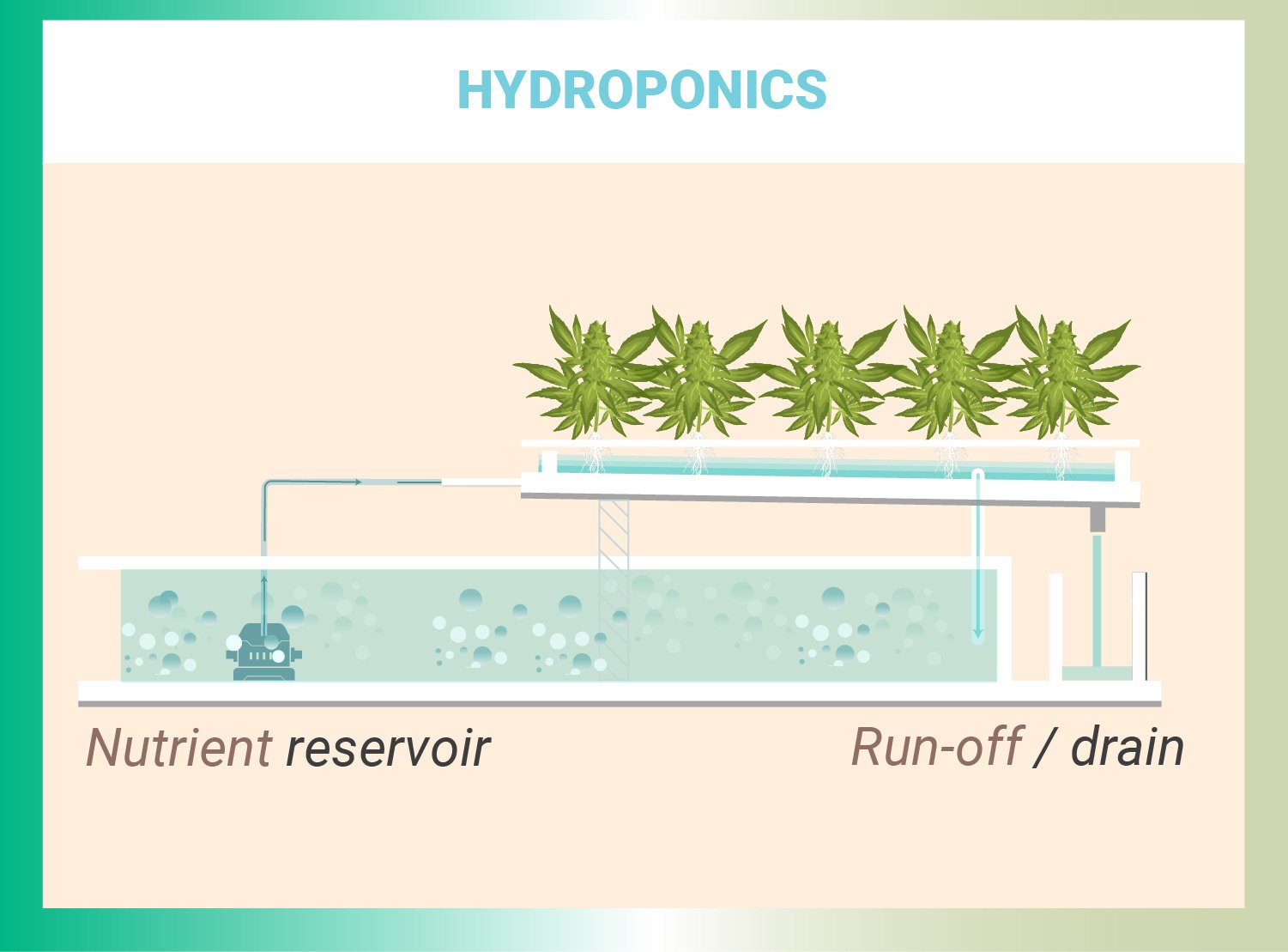
How To Decipher Your Runoff Results
For a clear picture of how much nutrients your plants are getting, you need to measure the PPM or EC of both your nutrient solution/reservoir (if you’re using hydroponics) and your runoff. Ideally, the PPM or EC reading of your runoff should always be lower, which shows your plants are taking up nutrients when you feed them. If your PPM/EC readings are super low in your runoff, it’s a sign you need to up your nutrients.
If there is no change in PPM/EC between your nutrients and runoff, this means your plants aren’t taking up nutrients properly. This is usually caused by spikes or drops in pH.
If the PPM/EC reading is higher in your runoff than in your nutrient solution, you’ll likely be dealing with salt buildup around the roots. As you feed your plants, this buildup slowly dissolves back into your runoff, driving up your PPM/EC readings. To deal with this, you’ll want to use an enzymatic line cleaner to clean your plants’ roots. Line cleaners remove any kind of nutrient buildup and can be mixed right into their water. Alternatively, you can also use filtered, pH-neutral water to flush your roots. Just keep in mind that this process takes multiple attempts.
| HYDROPONIC | SOIL | |||
|---|---|---|---|---|
| PPM (Hannah) | EC (mS/cm2) | PPM (Hannah) | EC (mS/cm2) | |
| Early Growth | 350 - 400 ppm | 0,7 - 0,8 | 400 - 500 ppm | 0,8 - 1 |
| Seedling | 400 - 500 ppm | 1 - 1,2 | 500 - 600 ppm | 1 - 1,3 |
| Transition | 550 - 650 ppm | 1,3 - 1,5 | 600 - 750 ppm | 1,2 - 1,5 |
| Vegetative Stage | 650 - 750 ppm | 1,6 - 1,7 | 800 - 850 ppm | 1,6 - 1,7 |
| Vegetative Stage | 750 - 800 ppm | 1,7 - 1,8 | 850 - 900 ppm | 1,7 - 1,8 |
| Vegetative Stage | 850 - 900 ppm | 1,8 - 1,9 | 900 - 950 ppm | 1,8 - 1,9 |
| Flowering Stage | 900 - 950 ppm | 1,9 - 2 | 950 - 1000 ppm | 1,9 - 2 |
| Flowering Stage | 950 - 1050 ppm | 2 - 2,2 | 1000 - 1050 ppm | 2 - 2,1 |
| Flowering Stage | 1050 - 1100 ppm | 2,2 - 2,3 | 1050 - 1100 ppm | 2,1 - 2,2 |
| Flowering Stage | 1100 - 1150 ppm | 2,3 - 2,4 | 1100 - 1150 ppm | 2,2 - 2,3 |
| Flushing | 0 - 400 ppm | 0 - 0,8 | 0 - 400 ppm | 0 - 0,8 |
| HYDROPONIC | ||
|---|---|---|
| PPM (Hannah) | EC (mS/cm2) | |
| Early Growth | 350 - 400 ppm | 0,7 - 0,8 |
| Seedling | 400 - 500 ppm | 1 - 1,2 |
| Transition | 550 - 650 ppm | 1,3 - 1,5 |
| Vegetative Stage | 650 - 750 ppm | 1,6 - 1,7 |
| Vegetative Stage | 750 - 800 ppm | 1,7 - 1,8 |
| Vegetative Stage | 850 - 900 ppm | 1,8 - 1,9 |
| Flowering Stage | 900 - 950 ppm | 1,9 - 2 |
| Flowering Stage | 950 - 1050 ppm | 2 - 2,2 |
| Flowering Stage | 1050 - 1100 ppm | 2,2 - 2,3 |
| Flowering Stage | 1100 - 1150 ppm | 2,3 - 2,4 |
| Flushing | 0 - 400 ppm | 0 - 0,8 |
| SOIL | ||
|---|---|---|
| PPM (Hannah) | EC (mS/cm2) | |
| Early Growth | 400 - 500 ppm | 0,8 - 1 |
| Seedling | 500 - 600 ppm | 1 - 1,3 |
| Transition | 600 - 750 ppm | 1,2 - 1,5 |
| Vegetative Stage | 800 - 850 ppm | 1,6 - 1,7 |
| Vegetative Stage | 850 - 900 ppm | 1,7 - 1,8 |
| Vegetative Stage | 900 - 950 ppm | 1,8 - 1,9 |
| Flowering Stage | 950 - 1000 ppm | 1,9 - 2 |
| Flowering Stage | 1000 - 1050 ppm | 2 - 2,1 |
| Flowering Stage | 1050 - 1100 ppm | 2,1 - 2,2 |
| Flowering Stage | 1100 - 1150 ppm | 2,2 - 2,3 |
| Flushing | 0 - 400 ppm | 0 - 0,8 |
PPM & EC
Knowing your PPM helps you avoid possible burning by letting you know when to adjust the amount of nutrient minerals you add to your water. Cannabis enjoys 500-600 ppm after cloning, 800-900 ppm when vegetating, and 1000-1100 ppm when flowering. So knowing the mineral content of your water before mixing your nutes can avoid stressing you and your plants. For DWC (hydroponic) growers, it is important to know the condition of the reservoir water, as minerals can deplete as the water level drops - it is a heads-up for you to just top things up as required.
There are many probes, devices and metres on the market all able to measure ppm. The most common is a TDS meter (total dissolved solids). What you go for really depends on your budget, and desire to get technical and nerdy with your grow. Most have a range of 3500, which is all you will ever need for cannabis, but if you like the overkill some will read up to 9999.
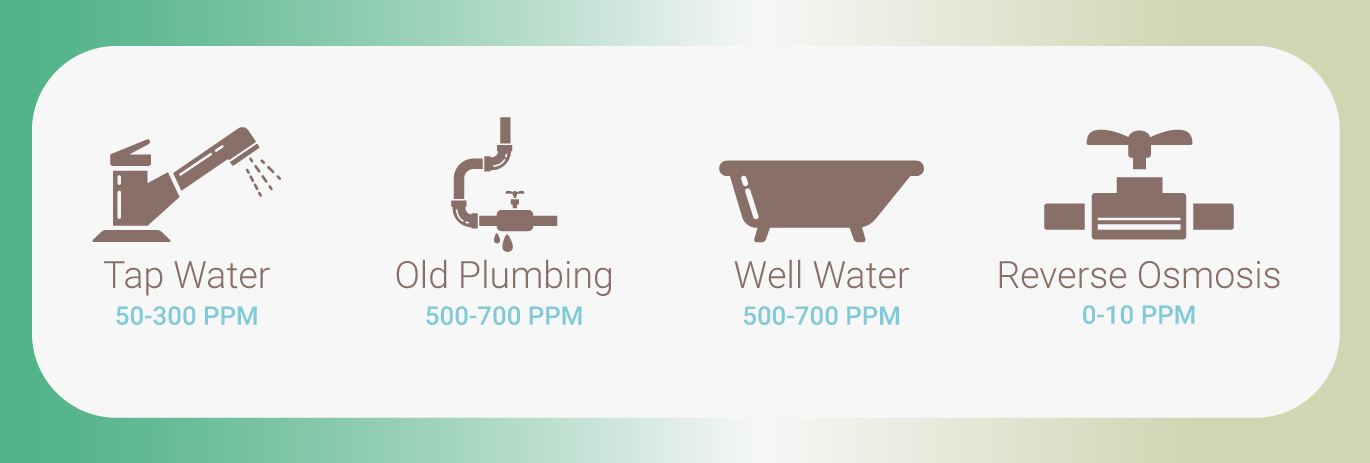
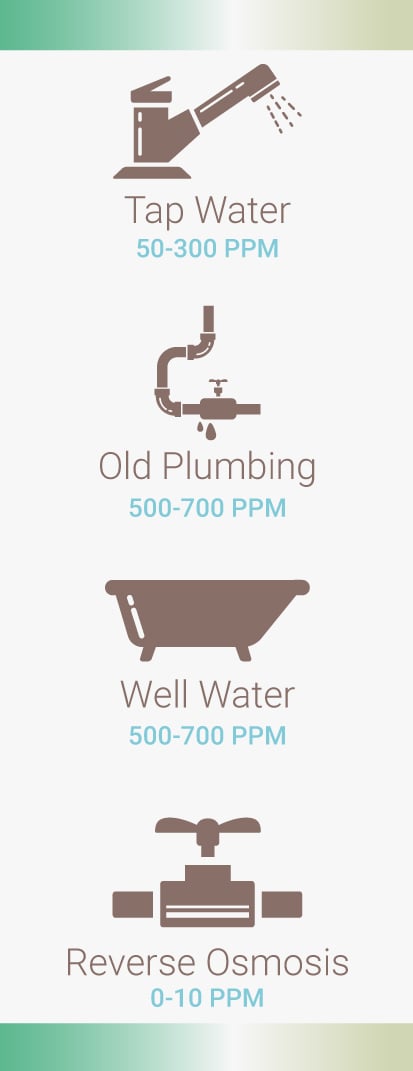
1. Once you have calibrated your TDS meter, turn it on, make sure it is reading zero and put it in the water you want to test – hey presto, there's your ppm reading. If you are using reverse osmosis water, the reading will be 0 to 10 ppm as it is completely free of minerals.
2. If you use tap water, your reading should be between 50 and 300 ppm here in the EU as standard.
3. If your town’s plumbing is old, or you are using well water from limestone strata, you may get a reading of up to 500 to 700ppm because of the mineral build up.
4. If your water is reading over 500 ppm, you need to do something about it, as it will compete with and lock out the nutrients you actually want your cannabis to uptake. Either you need to get some nutes designed to be used in hard-water areas, or you need to treat your water at home, either through carbon filters, distillation, or reverse osmosis.
Getting Technical With EC & PPM
This is where things get technical.
EC, or Electrical Conductivity, is a measure of the salinity of a water sample.
Saline water conducts electricity better than pure or reverse osmosis water because more ions are dissolved in it, and consequently, conductivity of the solution increases. Values can be measured in microsiemens per centimetre (µS/cm) or in milisiemens per centimetre (mS/cm) depending on the EC meter.
If your water is too saline, it can affect your plants in two ways. It can increase the toxicity of singular ions at the root ball and increase osmotic pressure at the roots inhibiting nutrient uptake.
PPM measures the overall mineral content of your water, regardless of what those minerals are.
Accurate ppm readings are obtained by gently evaporating the water sample and analysing the remaining residue. Other than sodium chloride most other minerals are hardly present in nearly all naturally occurring water and are not of any real worry. These minerals are usually trace amounts of calcium carbonate, magnesium and micro traces of several other elements.
If you approach your local water authority, they can usually supply you with a mineral analysis of your local water supply.
There are conversions for microsiemens per centimetre to parts per million and back again but most metres do these conversions for you.
Organic soil and outdoor growers have an advantage again when it comes to ppm and EC. The microorganisms provide a buffer that helps protect the plant from fluctuations in ppm or EC and there is a greater margin for error when watering.
Never be complacent, though. Always check your water quality, even from rivers and creeks. You never know what could be washed in upstream during rain that could make your water toxic.

Extra Water Quality Tips
• Who thinks rain water is neutral? It is a common misconception and is actually mildly acidic. Carbon dioxide dissolves in rain and makes it into a weak carbonic acid with a pH of about 5.6. Don't worry, though, once it has sat for a while in a tank or dam or reservoir it releases the carbon dioxide and balances out at 7. Ever noticed how plants grow like mad after rain? That’s why.
• When you put your water through a reverse osmosis filter, it makes your water completely mineral free. Never use this water unmodified to flush your plants or as a foliage spray. RO water will strip nutrients from your plants, especially calcium and magnesium. Label your bottles clearly.
• Put aerators on your faucets. If filling a container with a hose, make the water froth and bubble to enliven and oxygenate.
• In cold climates try and keep your water at 25°C.
There you have it! Things get quite technical, so don’t worry if it takes a while to pick up. Actively working to ensure you have the best water quality you can will help minimise any potential growing problems, as well as give your cannabis what it needs to thrive. The more you know!
 Grow Guide Topic Finder
Grow Guide Topic Finder
- Growing weed step by step
- Cannabis growing basics
- Choosing your seeds
- How to germinate seeds
- The cannabis vegetative stage
- The cannabis flowering stage
- Harvesting cannabis
- Trimming, drying, and curing
- Choosing pots and soil
-
Growing indoors
- A Complete Overview Of Growing Cannabis Indoors
- Cannabis Cultivation Tips: How To Set Up Indoor Grow Lights
- How Many Cannabis Plants Can You Grow Per Square Metre?
- Indoor Cannabis Growing: Relative Humidity and Temperatures
- Hydroponics Cannabis Growing Guide (with diagrams)
- Cannabis Micro Growing: Growing Great Weed in Tiny Spaces
- Growing outdoors
- How to grow autoflowering cannabis
- Cannabis nutrients and pH
- Cannabis troubleshooting: Nutrients
-
Cannabis troubleshooting: Growing
- Cannabis Seed Germination — Troubleshooting Guide
- How to Deal With Pythium (Root Rot) in Cannabis Plants
- Slow Cannabis Plant Growth And What You Can Do About It
- How to Prevent and Fix Stretching in Cannabis Seedlings
- Watering Your Cannabis: How to Fix Overwatering and Underwatering
- Understanding Male, Female, And Hermaphrodite Cannabis
- Identifying and Treating Common Cannabis Ailments
- How To Revive a Sick Cannabis Plant
- How to Avoid Mouldy Weed During Drying and Curing
- How to Prevent and Treat Dry and Crispy Cannabis Leaves
- What Cannabis Leaves Can Tell You
- Causes and Solutions for Yellow Cannabis Leaves
-
Cannabis Strains Grow Report
- HulkBerry Automatic Grow Report
- Blue Cheese Auto Grow Report
- Purple Punch Automatic Grow Report
- Triple G Automatic Grow Report
- Do-Si-Dos Automatic Grow Report
- Green Gelato Automatic Grow Report
- Haze Berry Automatic Grow Report
- Purple Queen Automatic Grow Report
- Cookies Gelato Automatic Grow Report
- Sherbet Queen Automatic Grow Report
- Sweet Skunk Automatic Grow Report
- Medusa F1 Grow Report
- Cannabis plant training
-
Weed growing tips
- The Cannabis Plant Anatomy
- How to preserve seeds
- How Much Sunlight Do Outdoor Cannabis Plants Need To Grow?
- How to Control and Prevent Stretching in Cannabis Plants
- My Cannabis Plants Are Growing Too Tall: What Should I Do?
- Should You Worry About Purple Or Red Cannabis Stems?
- What To Do When Your Indoor Cannabis Won’t Flower
- How To Protect Your Cannabis Plants From Heat Stress
- How To Tell If Your Female Cannabis Plant Has Been Pollinated
- Growing Medical Marijuana
- Bud Washing: How to Clean Your Weed
- Understanding Cannabis Yield per Plant






























